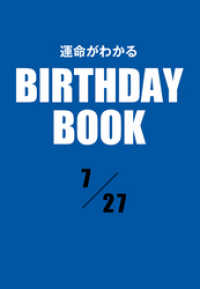- ホーム
- > 洋書
- > 英文書
- > Cinema / Film
基本説明
By identifying the apartment plot as a film genre, Wojcik reveals affinities between movies generally viewed as belonging to such distinct genres as film noir, romantic comedy, and melodrama.
Full Description
Rethinking the significance of films including Pillow Talk, Rear Window, and The Seven Year Itch, Pamela Robertson Wojcik examines the popularity of the "apartment plot," her term for stories in which the apartment functions as a central narrative device. From the baby boom years into the 1970s, the apartment plot was not only key to films; it also surfaced in TV shows, Broadway plays, literature, and comic strips, from The Honeymooners and The Mary Tyler Moore Show to Subways are for Sleeping and Apartment 3-G. By identifying the apartment plot as a film genre, Wojcik reveals affinities between movies generally viewed as belonging to such distinct genres as film noir, romantic comedy, and melodrama. She analyzes the apartment plot as part of a mid-twentieth-century urban discourse, showing how it offers a vision of home centered on values of community, visibility, contact, mobility, impermanence, and porousness that contrasts with views of home as private, stable, and family-based. Wojcik suggests that the apartment plot presents a philosophy of urbanism related to the theories of Jane Jacobs and Henri Lefebvre. Urban apartments were important spaces for negotiating gender, sexuality, race, and class in mid-twentieth-century America.
Contents
List of Illustrations vii
Preface ix
Introduction: A Philosophy of Urbanism 1
1. A Primer in Urbanism: Rear Window's Archetypal Apartment Plot 47
2. "We Like Our Apartment": The Playboy Indoors 88
3. The Great Reprieve: Modernity, Femininity, and the Apartment 139
4. The Suburbs in the City: The Housewife and the Apartment 180
5. Movin' On Up: The African American Apartment 220
Epilogue: A New Philosophy for a New Century 267
Notes 279
Bibliography 289
Index 303
-

- 電子書籍
- 時々ボソッとロシア語でデレる隣のアーリ…
-

- 電子書籍
- 塔子さんはいい大人じゃいられない【単話…
-

- 電子書籍
- 追憶の重さ【分冊】 11巻 ハーレクイ…
-

- 電子書籍
- 運命がわかるBIRTHDAY BOOK…




